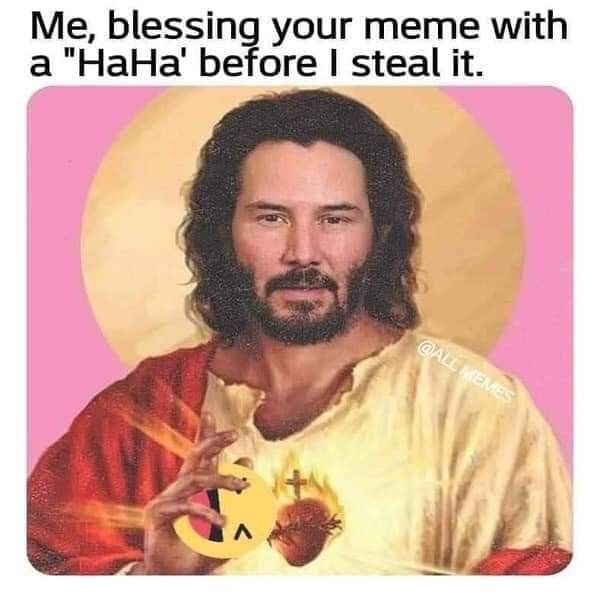Ethics of copying
Contents
12.5. Ethics of copying#
Elon Musk, who purchased Twitter in 2022 has long been known to copy others’ images and jokes and post them as his own without attribution (often specifically cropping images to hide any attribution) (source, source, source). So let’s consider ethical issues and complications around how content is copied on the internet.
12.5.1. Remixing#
Much of the internet has developed a culture of copying without necessarily giving attribution to where it came from. Often, unlike with Elon Musk, this copying also involves modifying the content, recontextualizing the content to give it new meaning, or combining it with other content.
For example, let’s look at this meme about stealing memes:

Fig. 12.12 A meme about stealing memes. (It is unclear how we should or even could cite this).#
The meme above is composed of many pieces copied from elsewhere, and modified and put together. Here are the pieces we could identify:
A painting: SACRED HEART OF JESUS by Dona Gelsinger (which itself is copying its form from centuries of paintings of the sacred heart)
The background was switched out to make a yellow disk halo behind the head of Jesus
Jesus’ face is replaced with Keanu Reeves’ bearded face (perhaps from the spongebob movie)
A laughing emoticon is placed in Jesus’ hand.
A watermark from @AllMemes appears on Jesus’ shoulder.
The text about stealing memes is added at the top
Communities based on this type of remixing have existed outside the Internet before showing up in internet-based social media platforms, such as sampling in hip-hop music in the 1980s.
In an anthropological introduction to YouTube (from 2008), Michael Wesch observes this phenomenon:
And this is something really quite profound that’s happening. Where we can remix this culture that’s being thrown at us, where we can take it, re-appropriate it and throw it back. […] Most of what we do is actually illegal, any remixing is basically illegal. And I could talk more about the- the parameters of that, we have fair use laws that should protect it but the simple fact of ripping a DVD is actually illegal which makes virtually everything we do illegal.
12.5.2. Cultural appropriation#
The online community activity of copying and remixing can be a means of cultural appropriation, which is when one cultural group adopts something from another culture in an unfair or disrespectful way (as opposed to a fair, respectful cultural exchange). For example, many phrases from Black American culture have been appropriated by white Americans and had their meanings changed or altered (like “woke”, “cancel”, “shade”, “sip/spill the tea”, etc.).
Additionally, white Americans often use images and gifs of Black people reacting and expressing emotions. This modern practice with gifs has been compared to the earlier (and racist) art forms of blackface, where white actors would paint their faces black and then act in exaggerated unintelligent ways.
12.5.3. Citation and giving credit#

Fig. 12.13 The “This is fine” meme image by K.C. Green#
On the 10th anniversary of the webcomic by K.C. Green where the “This is fine” meme came from, he reflected on his feelings about how those frames from his comic became a viral meme:
When a work gets as big as this has, is it still yours? Not talking about copyright and legal stuff. It says something larger that everyone can feel and relate to.
[…]
I’ve been forced time and time again with these 6 panels, to be the party pooper, gate-keeper, girlboss, etc and just to get people to recognize there are artists behind these drawings online. These memes we share.
[…]
So I do what I can and try to keep in good humor and be thankful that I can still do what I do for a living.
Given the community activities on social media of copying, remixing, cultural appropriate, and cultural exchange:
How do you think attribution should work when copying and reusing content on social media (like if you post a meme or gif on social media)?
When is it ok to not cite sources for content?
When should sources be cited, and how should they be cited?
How can you participate in cultural exchange without harmful cultural appropriation?
